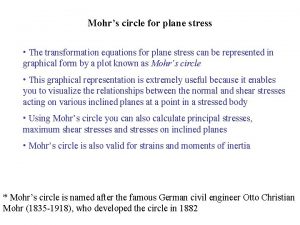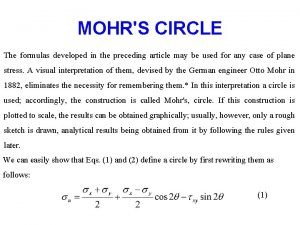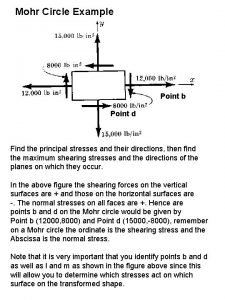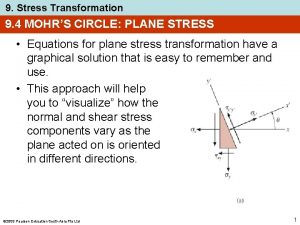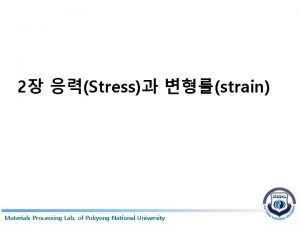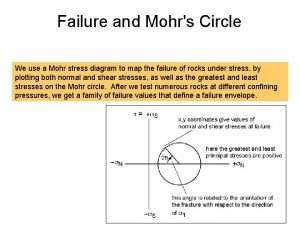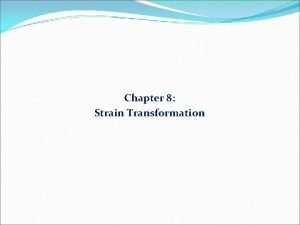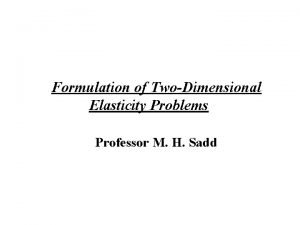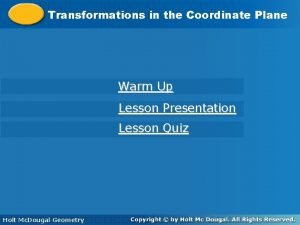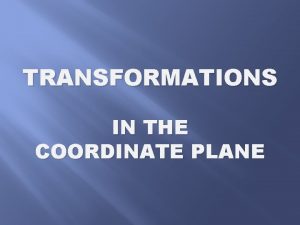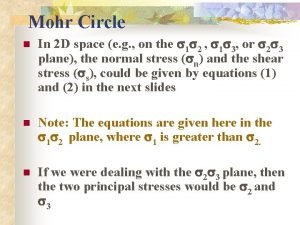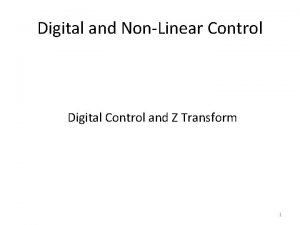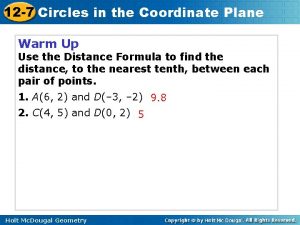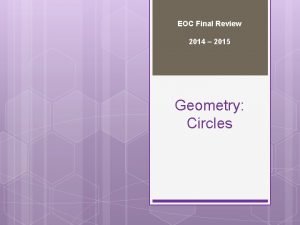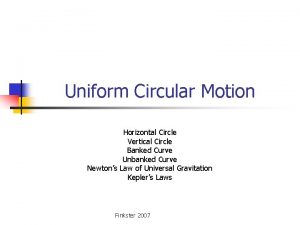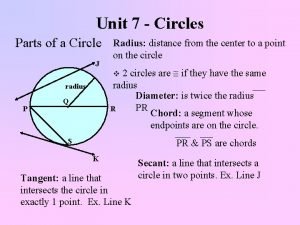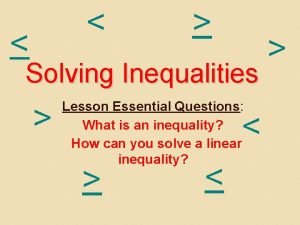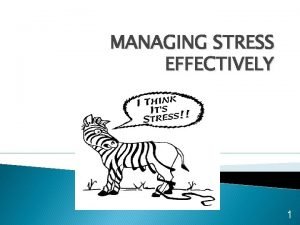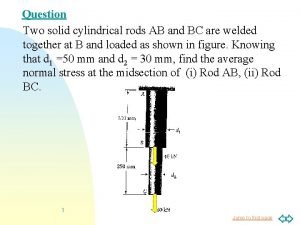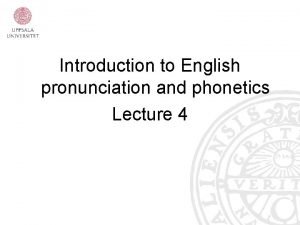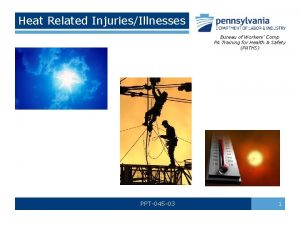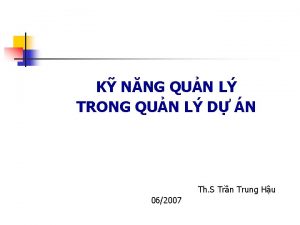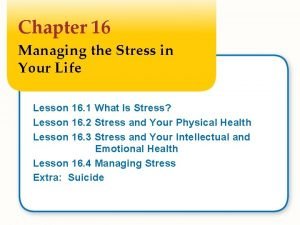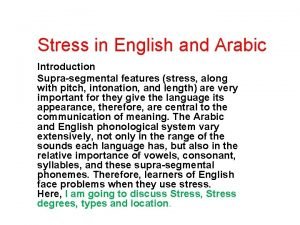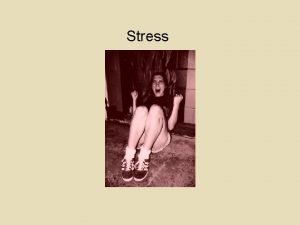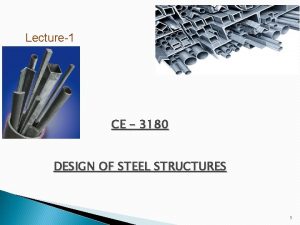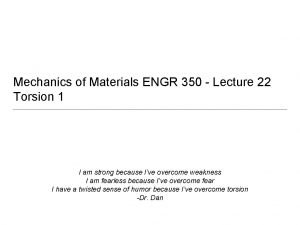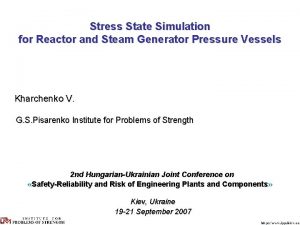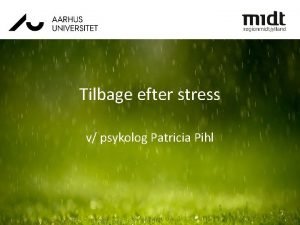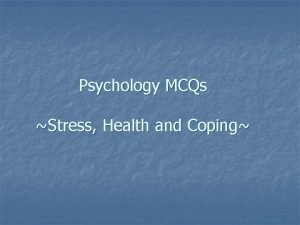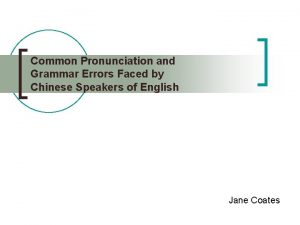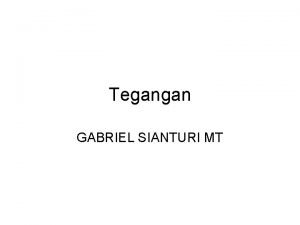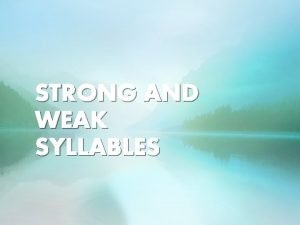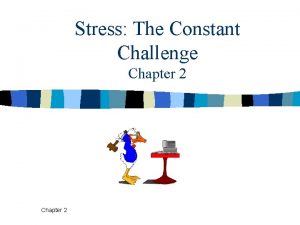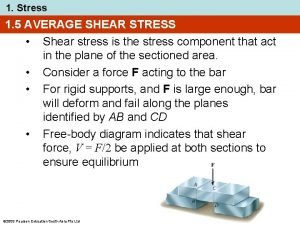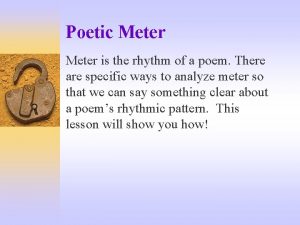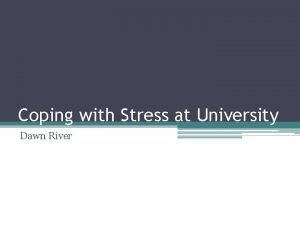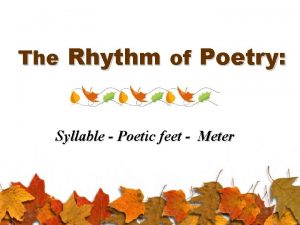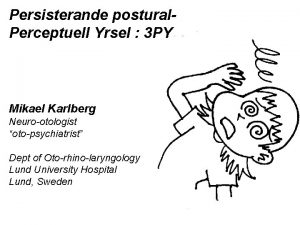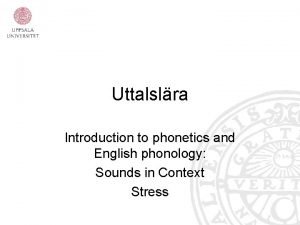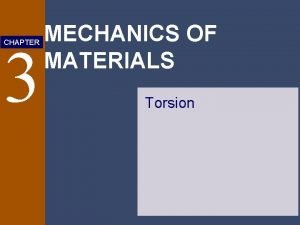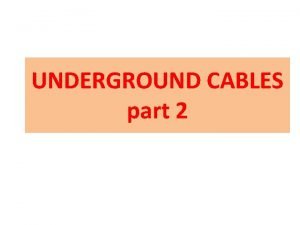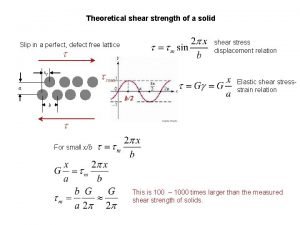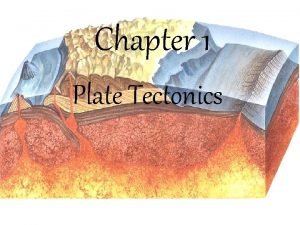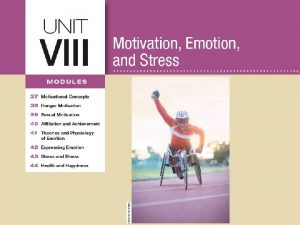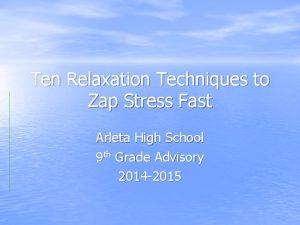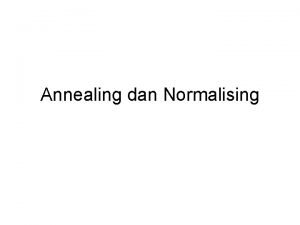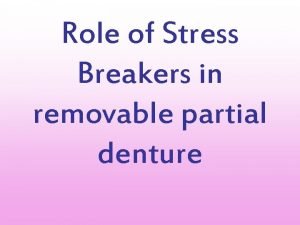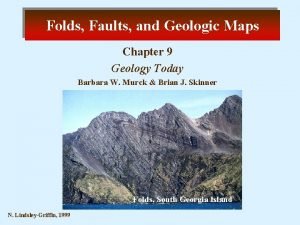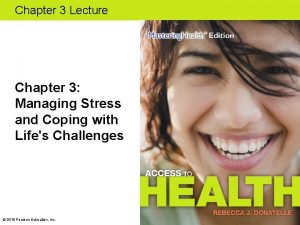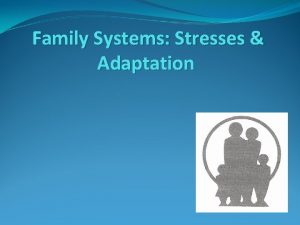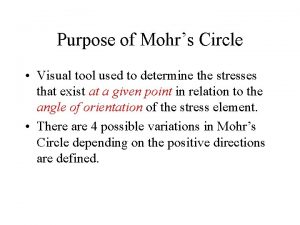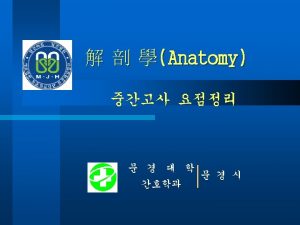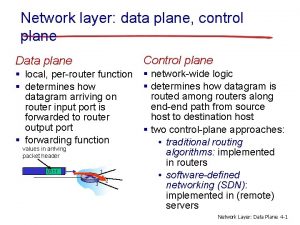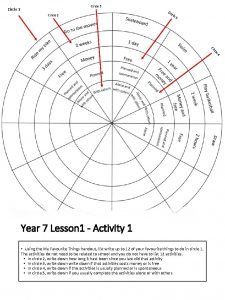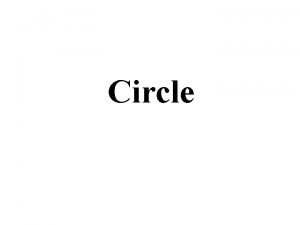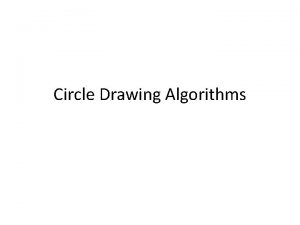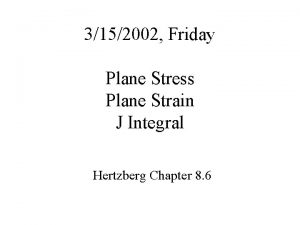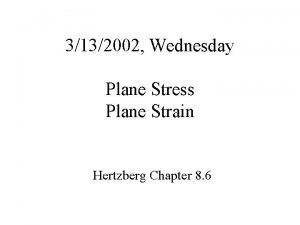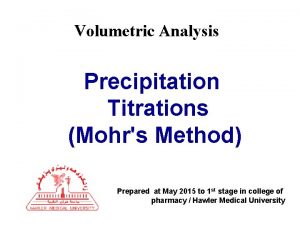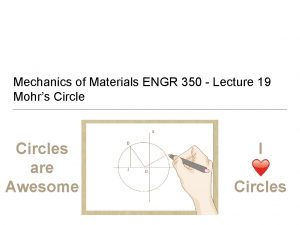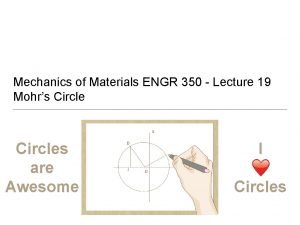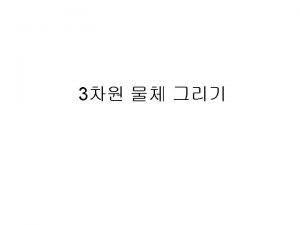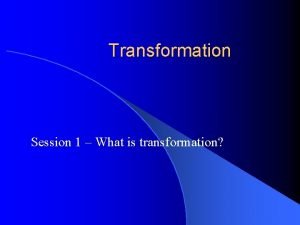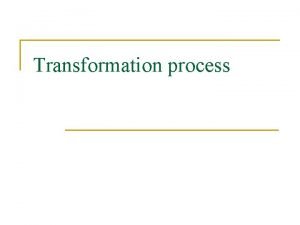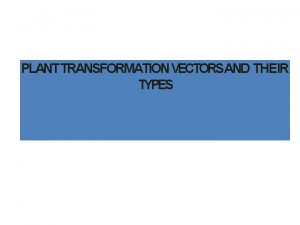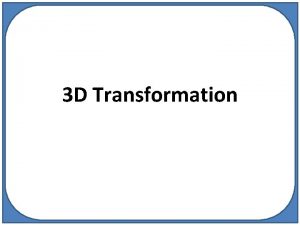9 Stress Transformation 9 4 MOHRS CIRCLE PLANE





































































- Slides: 69

9. Stress Transformation 9. 4 MOHR’S CIRCLE: PLANE STRESS • Equations for plane stress transformation have a graphical solution that is easy to remember and use. • This approach will help you to “visualize” how the normal and shear stress components vary as the plane acted on is oriented in different directions. 2005 Pearson Education South Asia Pte Ltd 1

9. Stress Transformation 9. 4 MOHR’S CIRCLE: PLANE STRESS • Eqns 9 -1 and 9 -2 are rewritten as • Parameter can be eliminated by squaring each eqn and adding them together. 2005 Pearson Education South Asia Pte Ltd 2

9. Stress Transformation 9. 4 MOHR’S CIRCLE: PLANE STRESS • If x, y, xy are known constants, thus we compact the Eqn as, 2005 Pearson Education South Asia Pte Ltd 3

9. Stress Transformation 9. 4 MOHR’S CIRCLE: PLANE STRESS • Establish coordinate axes; positive to the right and positive downward, Eqn 9 -11 represents a circle having radius R and center on the axis at pt C ( avg, 0). This is called the Mohr’s Circle. 2005 Pearson Education South Asia Pte Ltd 4

9. Stress Transformation 9. 4 MOHR’S CIRCLE: PLANE STRESS • To draw the Mohr’s circle, we must establish the and axes. • Center of circle C ( avg, 0) is plotted from the known stress components ( x, y, xy). • We need to know at least one pt on the circle to get the radius of circle. 2005 Pearson Education South Asia Pte Ltd 5

9. Stress Transformation 9. 4 MOHR’S CIRCLE: PLANE STRESS Case 1 (x’ axis coincident with x axis) 1. = 0 2. x’ = x 3. x’y’ = xy. • Consider this as reference pt A, and plot its coordinates A ( x, xy). • Apply Pythagoras theorem to shaded triangle to determine radius R. • Using pts C and A, the circle can now be drawn. 2005 Pearson Education South Asia Pte Ltd 6

9. Stress Transformation 9. 4 MOHR’S CIRCLE: PLANE STRESS Case 2 (x’ axis rotated 90 counterclockwise) 1. = 90 2. x’ = y 3. x’y’ = xy. • Its coordinates are G ( y, xy). • Hence radial line CG is 180 counterclockwise from “reference line” CA. 2005 Pearson Education South Asia Pte Ltd 7

9. Stress Transformation 9. 4 MOHR’S CIRCLE: PLANE STRESS Procedure for Analysis Construction of the circle 1. Establish coordinate system where abscissa represents the normal stress , (+ve to the right), and the ordinate represents shear stress , (+ve downward). 2. Use positive sign convention for x, y, xy, plot the center of the circle C, located on the axis at a distance avg = ( x + y)/2 from the origin. 2005 Pearson Education South Asia Pte Ltd 8

9. Stress Transformation 9. 4 MOHR’S CIRCLE: PLANE STRESS Procedure for Analysis Construction of the circle 3. Plot reference pt A ( x, xy). This pt represents the normal and shear stress components on the element’s right-hand vertical face. Since x’ axis coincides with x axis, = 0. 2005 Pearson Education South Asia Pte Ltd 9

9. Stress Transformation 9. 4 MOHR’S CIRCLE: PLANE STRESS Procedure for Analysis Construction of the circle 4. Connect pt A with center C of the circle and determine CA by trigonometry. The distance represents the radius R of the circle. 5. Once R has been determined, sketch the circle. 2005 Pearson Education South Asia Pte Ltd 10

9. Stress Transformation 9. 4 MOHR’S CIRCLE: PLANE STRESS Procedure for Analysis Principal stress • Principal stresses 1 and 2 ( 1 2) are represented by two pts B and D where the circle intersects the -axis. 2005 Pearson Education South Asia Pte Ltd 11

9. Stress Transformation 9. 4 MOHR’S CIRCLE: PLANE STRESS Procedure for Analysis Principal stress • These stresses act on planes defined by angles p 1 and p 2. They are represented on the circle by angles 2 p 1 and 2 p 2 and measured from radial reference line CA to lines CB and CD respectively. 2005 Pearson Education South Asia Pte Ltd 12

9. Stress Transformation 9. 4 MOHR’S CIRCLE: PLANE STRESS Procedure for Analysis Principal stress • Using trigonometry, only one of these angles needs to be calculated from the circle, since p 1 and p 2 are 90 apart. Remember that direction of rotation 2 p on the circle represents the same direction of rotation p from reference axis (+x) to principal plane (+x’). 2005 Pearson Education South Asia Pte Ltd 13

9. Stress Transformation 9. 4 MOHR’S CIRCLE: PLANE STRESS Procedure for Analysis Maximum in-plane shear stress • The average normal stress and maximum in-plane shear stress components are determined from the circle as the coordinates of either pt E or F. 2005 Pearson Education South Asia Pte Ltd 14

9. Stress Transformation 9. 4 MOHR’S CIRCLE: PLANE STRESS Procedure for Analysis Maximum in-plane shear stress • The angles s 1 and s 2 give the orientation of the planes that contain these components. The angle 2 s can be determined using trigonometry. Here rotation is clockwise, and so s 1 must be clockwise on the element. 2005 Pearson Education South Asia Pte Ltd 15

9. Stress Transformation 9. 4 MOHR’S CIRCLE: PLANE STRESS Procedure for Analysis Stresses on arbitrary plane • Normal and shear stress components x’ and x’y’ acting on a specified plane defined by the angle , can be obtained from the circle by using trigonometry to determine the coordinates of pt P. 2005 Pearson Education South Asia Pte Ltd 16

9. Stress Transformation 9. 4 MOHR’S CIRCLE: PLANE STRESS Procedure for Analysis Stresses on arbitrary plane • To locate pt P, known angle for the plane (in this case counterclockwise) must be measured on the circle in the same direction 2 (counterclockwise), from the radial reference line CA to the radial line CP. 2005 Pearson Education South Asia Pte Ltd 17

9. Stress Transformation EXAMPLE 9. 9 Due to applied loading, element at pt A on solid cylinder as shown is subjected to the state of stress. Determine the principal stresses acting at this pt. 2005 Pearson Education South Asia Pte Ltd 18

9. Stress Transformation EXAMPLE 9. 9 (SOLN) Construction of the circle • Center of the circle is at • Initial pt A ( 2, 6) and the center C ( 6, 0) are plotted as shown. The circle having a radius of 2005 Pearson Education South Asia Pte Ltd 19

9. Stress Transformation EXAMPLE 9. 9 (SOLN) Principal stresses • Principal stresses indicated at pts B and D. For 1 > 2, • Obtain orientation of element by calculating counterclockwise angle 2 p 2, which defines the direction of p 2 and its associated principal plane. 2005 Pearson Education South Asia Pte Ltd 20

9. Stress Transformation EXAMPLE 9. 9 (SOLN) Principal stresses • The element is orientated such that x’ axis or 2 is directed 22. 5 counterclockwise from the horizontal x-axis. 2005 Pearson Education South Asia Pte Ltd 21

9. Stress Transformation EXAMPLE 9. 10 State of plane stress at a pt is shown on the element. Determine the maximum in-plane shear stresses and the orientation of the element upon which they act. 2005 Pearson Education South Asia Pte Ltd 22

9. Stress Transformation EXAMPLE 9. 10 (SOLN) Construction of circle • Establish the , axes as shown below. Center of circle C located on the -axis, at the pt: 2005 Pearson Education South Asia Pte Ltd 23

9. Stress Transformation EXAMPLE 9. 10 (SOLN) Construction of circle • Pt C and reference pt A ( 20, 60) are plotted. Apply Pythagoras theorem to shaded triangle to get circle’s radius CA, 2005 Pearson Education South Asia Pte Ltd 24

9. Stress Transformation EXAMPLE 9. 10 (SOLN) Maximum in-plane shear stress • Maximum in-plane shear stress and average normal stress are identified by pt E or F on the circle. In particular, coordinates of pt E (35, 81. 4) gives 2005 Pearson Education South Asia Pte Ltd 25

9. Stress Transformation EXAMPLE 9. 10 (SOLN) Maximum in-plane shear stress • Counterclockwise angle s 1 can be found from the circle, identified as 2 s 1. 2005 Pearson Education South Asia Pte Ltd 26

9. Stress Transformation EXAMPLE 9. 10 (SOLN) Maximum in-plane shear stress • This counterclockwise angle defines the direction of the x’ axis. Since pt E has positive coordinates, then the average normal stress and maximum in-plane shear stress both act in the positive x’ and y’ directions as shown. 2005 Pearson Education South Asia Pte Ltd 27

9. Stress Transformation EXAMPLE 9. 11 State of plane stress at a pt is shown on the element. Represent this state of stress on an element oriented 30 counterclockwise from position shown. 2005 Pearson Education South Asia Pte Ltd 28

9. Stress Transformation EXAMPLE 9. 11 (SOLN) Construction of circle • Establish the , axes as shown. Center of circle C located on the -axis, at the pt: 2005 Pearson Education South Asia Pte Ltd 29

9. Stress Transformation EXAMPLE 9. 11 (SOLN) Construction of circle • Initial pt for = 0 has coordinates A ( 8, 6) are plotted. Apply Pythagoras theorem to shaded triangle to get circle’s radius CA, 2005 Pearson Education South Asia Pte Ltd 30

9. Stress Transformation EXAMPLE 9. 11 (SOLN) Stresses on 30 element • Since element is rotated 30 counterclockwise, we must construct a radial line CP, 2(30 ) = 60 counterclockwise, measured from CA ( = 0 ). • Coordinates of pt P ( x’, x’y’) must be obtained. From geometry of circle, 2005 Pearson Education South Asia Pte Ltd 31

9. Stress Transformation EXAMPLE 9. 11 (SOLN) Stresses on 30 element • The two stress components act on face BD of element shown, since the x’ axis for this face if oriented 30 counterclockwise from the x-axis. • Stress components acting on adjacent face DE of element, which is 60 clockwise from +x-axis, are represented by the coordinates of pt Q on the circle. • This pt lies on the radial line CQ, which is 180 from CP. 2005 Pearson Education South Asia Pte Ltd 32

9. Stress Transformation EXAMPLE 9. 11 (SOLN) Stresses on 30 element • The coordinates of pt Q are • Note that here x’y’ acts in the y’ direction. 2005 Pearson Education South Asia Pte Ltd 33

9. Stress Transformation 9. 5 STRESS IN SHAFTS DUE TO AXIAL LOAD AND TORSION • Occasionally, circular shafts are subjected to combined effects of both an axial load and torsion. • Provided materials remain linear elastic, and subjected to small deformations, we use principle of superposition to obtain resultant stress in shaft due to both loadings. • Principal stress can be determined using either stress transformation equations or Mohr’s circle. 2005 Pearson Education South Asia Pte Ltd 34

9. Stress Transformation EXAMPLE 9. 12 Axial force of 900 N and torque of 2. 50 N m are applied to shaft. If shaft has a diameter of 40 mm, determine the principal stresses at a pt P on its surface. 2005 Pearson Education South Asia Pte Ltd 35

9. Stress Transformation EXAMPLE 9. 12 (SOLN) Internal loadings • Consist of torque of 2. 50 N m and axial load of 900 N. Stress components • Stresses produced at pt P are therefore 2005 Pearson Education South Asia Pte Ltd 36

9. Stress Transformation EXAMPLE 9. 12 (SOLN) Principal stresses • Using Mohr’s circle, center of circle C at the pt is • Plotting C (358. 1, 0) and reference pt A (0, 198. 9), the radius found was R = 409. 7 k. PA. Principal stresses represented by pts B and D. 2005 Pearson Education South Asia Pte Ltd 37

9. Stress Transformation EXAMPLE 9. 12 (SOLN) Principal stresses • Clockwise angle 2 p 2 can be determined from the circle. It is 2 p 2 = 29. 1. The element is oriented such that the x’ axis or 2 is directed clockwise p 1 = 14. 5 with the x axis as shown. 2005 Pearson Education South Asia Pte Ltd 38

9. Stress Transformation 9. 6 STRESS VARIATIONS THROUGHOUT A PRISMATIC BEAM • The shear and flexure formulas are applied to a cantilevered beam that has a rectangular x-section and supports a load P at its end. • At arbitrary section a-a along beam’s axis, internal shear V and moment M are developed from a parabolic shear-stress distribution, and a linear normal-stress distribution. 2005 Pearson Education South Asia Pte Ltd 39

9. Stress Transformation 9. 6 STRESS VARIATIONS THROUGHOUT A PRISMATIC BEAM • The stresses acting on elements at pts 1 through 5 along the section. • In each case, the state of stress can be transformed into principal stresses, using either stress-transformation equations or Mohr’s circle. • Maximum tensile stress acting on vertical faces of element 1 becomes smaller on corresponding faces of successive elements, until it’s zero on element 5. 2005 Pearson Education South Asia Pte Ltd 40

9. Stress Transformation 9. 6 STRESS VARIATIONS THROUGHOUT A PRISMATIC BEAM • Similarly, maximum compressive stress of vertical faces of element 5 reduces to zero on that of element 1. • By extending this analysis to many vertical sections along the beam, a profile of the results can be represented by curves called stress trajectories. • Each curve indicate the direction of a principal stress having a constant magnitude. 2005 Pearson Education South Asia Pte Ltd 41

9. Stress Transformation EXAMPLE 9. 13 Beam is subjected to the distributed loading of = 120 k. N/m. Determine the principal stresses in the beam at pt P, which lies at the top of the web. Neglect the size of the fillets and stress concentrations at this pt. I = 67. 1(10 -6) m 4. 2005 Pearson Education South Asia Pte Ltd 42

9. Stress Transformation EXAMPLE 9. 13 (SOLN) Internal loadings • Support reaction on the beam B is determined, and equilibrium of sectioned beam yields Stress components • At pt P, 2005 Pearson Education South Asia Pte Ltd 43

9. Stress Transformation EXAMPLE 9. 13 (SOLN) Stress components • At pt P, Principal stresses • Using Mohr’s circle, the principal stresses at P can be determined. 2005 Pearson Education South Asia Pte Ltd 44

9. Stress Transformation EXAMPLE 9. 13 (SOLN) Principal stresses • As shown, the center of the circle is at ( 45. 4 + 0)/2 = 22. 7, and pt A ( 45. 4, 35. 2). We find that radius R = 41. 9, therefore • The counterclockwise angle 2 p 2 = 57. 2 , so that 2005 Pearson Education South Asia Pte Ltd 45

9. Stress Transformation 9. 7 ABSOLUTE MAXIMUM SHEAR STRESS • A pt in a body subjected to a general 3 -D state of stress will have a normal stress and 2 shear-stress components acting on each of its faces. • We can develop stress-transformation equations to determine the normal and shear stress components acting on ANY skewed plane of the element. 2005 Pearson Education South Asia Pte Ltd 46

9. Stress Transformation 9. 7 ABSOLUTE MAXIMUM SHEAR STRESS • These principal stresses are assumed to have maximum, intermediate and minimum intensity: max int min. • Assume that orientation of the element and principal stress are known, thus we have a condition known as triaxial stress. 2005 Pearson Education South Asia Pte Ltd 47

9. Stress Transformation 9. 7 ABSOLUTE MAXIMUM SHEAR STRESS • Viewing the element in 2 D (y’-z’, x’-y’) we then use Mohr’s circle to determine the maximum in-plane shear stress for each case. 2005 Pearson Education South Asia Pte Ltd 48

9. Stress Transformation 9. 7 ABSOLUTE MAXIMUM SHEAR STRESS • As shown, the element have a 45 orientation and is subjected to maximum in-plane shear and average normal stress components. 2005 Pearson Education South Asia Pte Ltd 49

9. Stress Transformation 9. 7 ABSOLUTE MAXIMUM SHEAR STRESS • Comparing the 3 circles, we see that the absolute maximum shear stress is defined by the circle having the largest radius. • This condition can also be determined directly by choosing the maximum and minimum principal stresses: 2005 Pearson Education South Asia Pte Ltd 50

9. Stress Transformation 9. 7 ABSOLUTE MAXIMUM SHEAR STRESS • Associated average normal stress • We can show that regardless of the orientation of the plane, specific values of shear stress on the plane is always less than absolute maximum shear stress found from Eqn 9 -13. • The normal stress acting on any plane will have a value lying between maximum and minimum principal stresses, max min. 2005 Pearson Education South Asia Pte Ltd 51

9. Stress Transformation 9. 7 ABSOLUTE MAXIMUM SHEAR STRESS Plane stress • Consider a material subjected to plane stress such that the in-plane principal stresses are represented as max and int, in the x’ and y’ directions respectively; while the out-of-plane principal stress in the z’ direction is min = 0. • By Mohr’s circle and Eqn. 9 -13, 2005 Pearson Education South Asia Pte Ltd 52

9. Stress Transformation 9. 7 ABSOLUTE MAXIMUM SHEAR STRESS Plane stress • If one of the principal stresses has an opposite sign of the other, then these stresses are represented as max and min, and out-of-plane principal stress int = 0. • By Mohr’s circle and Eqn. 9 -13, 2005 Pearson Education South Asia Pte Ltd 53

9. Stress Transformation 9. 7 ABSOLUTE MAXIMUM SHEAR STRESS IMPORTANT • The general 3 -D state of stress at a pt can be represented by an element oriented so that only three principal stresses act on it. • From this orientation, orientation of element representing the absolute maximum shear stress can be obtained by rotating element 45 about the axis defining the direction of int. • If in-plane principal stresses both have the same sign, the absolute maximum shear stress occurs out of the plane, and has a value of 2005 Pearson Education South Asia Pte Ltd 54

9. Stress Transformation 9. 7 ABSOLUTE MAXIMUM SHEAR STRESS IMPORTANT • If in-plane principal stresses are of opposite signs, the absolute maximum shear stress equals the maximum in-plane shear stress; that is 2005 Pearson Education South Asia Pte Ltd 55

9. Stress Transformation EXAMPLE 9. 14 Due to applied loading, element at the pt on the frame is subjected to the state of plane stress shown. Determine the principal stresses and absolute maximum shear stress at the pt. 2005 Pearson Education South Asia Pte Ltd 56

9. Stress Transformation EXAMPLE 9. 14 (SOLN) Principal stresses The in-plane principal stresses can be determined from Mohr’s circle. Center of circle is on the axis at avg = ( 20 + 20)/2 = 10 k. Pa. Plotting controlling pt A ( 20, 40), circle can be drawn as shown. The radius is 2005 Pearson Education South Asia Pte Ltd 57

9. Stress Transformation EXAMPLE 9. 14 (SOLN) Principal stresses The principal stresses at the pt where the circle intersects the -axis: From the circle, counterclockwise angle 2 , measured from the CA to the axis is, 2005 Pearson Education South Asia Pte Ltd 58

9. Stress Transformation EXAMPLE 9. 14 (SOLN) Principal stresses This counterclockwise rotation defines the direction of the x’ axis or min and its associated principal plane. Since there is no principal stress on the element in the z direction, we have 2005 Pearson Education South Asia Pte Ltd 59

9. Stress Transformation EXAMPLE 9. 14 (SOLN) Absolute maximum shear stress Applying Eqns. 9 -13 and 9 -14, 2005 Pearson Education South Asia Pte Ltd 60

9. Stress Transformation EXAMPLE 9. 14 (SOLN) Absolute maximum shear stress These same results can be obtained by drawing Mohr’s circle for each orientation of an element about the x’, y’, and z’ axes. Since max and min are of opposite signs, then the absolute maximum shear stress equals the maximum in-plane shear stress. This results from a 45 rotation of the element about the z’ axis, so that the properly oriented element is shown. 2005 Pearson Education South Asia Pte Ltd 61

9. Stress Transformation EXAMPLE 9. 15 The pt on the surface of the cylindrical pressure vessel is subjected to the state of plane stress. Determine the absolute maximum shear stress at this pt. 2005 Pearson Education South Asia Pte Ltd 62

9. Stress Transformation EXAMPLE 9. 15 (SOLN) Principal stresses are max = 32 MPa, int = 16 MPa, and min = 0. If these stresses are plotted along the axis, the 3 Mohr’s circles can be constructed that describe the stress state viewed in each of the three perpendicular planes. The largest circle has a radius of 16 MPa and describes the state of stress in the plane containing max = 32 MPa and min = 0. An orientation of an element 45 within this plane yields the state of absolute maximum shear stress and the associated average normal stress, namely, 2005 Pearson Education South Asia Pte Ltd 63

9. Stress Transformation EXAMPLE 9. 15 (SOLN) An orientation of an element 45 within this plane yields the state of absolute maximum shear stress and the associated average normal stress, namely, Or we can apply Eqns 9 -13 and 9 -14: 2005 Pearson Education South Asia Pte Ltd 64

9. Stress Transformation EXAMPLE 9. 15 (SOLN) By comparison, maximum in-plane shear stress can be determined from the Mohr’s circle drawn between max = 32 MPa and int = 16 MPa, which gives a value of 2005 Pearson Education South Asia Pte Ltd 65

9. Stress Transformation CHAPTER REVIEW • Plane stress occurs when the material at a pt is subjected to two normal stress components x and y and a shear stress xy. • Provided these components are known, then the stress components acting on an element having a different orientation can be determined using the two force equations of equilibrium or the equations of stress transformation. 2005 Pearson Education South Asia Pte Ltd 66

9. Stress Transformation CHAPTER REVIEW • For design, it is important to determine the orientations of the element that produces the maximum principal normal stresses and the maximum in-plane shear stress. • Using the stress transformation equations, we find that no shear stress acts on the planes of principal stress. • The planes of maximum in-plane shear stress are oriented 45 from this orientation, and on these shear planes there is an associated average normal stress ( x + y)/2. 2005 Pearson Education South Asia Pte Ltd 67

9. Stress Transformation CHAPTER REVIEW • Mohr’s circle provides a semi-graphical aid for finding the stress on any plane, the principal normal stresses, and the maximum in-plane shear stress. • To draw the circle, the and axes are established, the center of the circle [( x + y)/2, 0], and the controlling pt ( x, xy) are plotted. • The radius of the circle extends between these two points and is determined from trigonometry. 2005 Pearson Education South Asia Pte Ltd 68

9. Stress Transformation CHAPTER REVIEW • The absolute maximum shear stress will be equal to the maximum in-plane shear stress, provided the in-plane principal stresses have the opposite sign. • If they are of the same sign, then the absolute maximum shear stress will lie out of plane. Its value is 2005 Pearson Education South Asia Pte Ltd 69
 Mohr circle equations
Mohr circle equations Mohrs circle equation
Mohrs circle equation Mohr
Mohr Mohr's circle stress transformation
Mohr's circle stress transformation 포아송비
포아송비 Data plane control plane and management plane
Data plane control plane and management plane Mohr circle formula
Mohr circle formula True stress and engineering stress
True stress and engineering stress Normal stress definition
Normal stress definition Chapter 10 stress responses and stress management
Chapter 10 stress responses and stress management Maximum principal
Maximum principal Xyyzzz
Xyyzzz Transformation in coordinate plane
Transformation in coordinate plane Transformation in the coordinate plane
Transformation in the coordinate plane Mohr circle for triaxial stress
Mohr circle for triaxial stress Forward equivalence class
Forward equivalence class Z transform is a non-linear operation
Z transform is a non-linear operation A circle is a plane figure
A circle is a plane figure Circles in the coordinate plane
Circles in the coordinate plane Circle a is tangent to circle b. true false
Circle a is tangent to circle b. true false Vertical
Vertical Circle j is congruent to circle p
Circle j is congruent to circle p Open circle on number line
Open circle on number line The stress response curve
The stress response curve Two solid rods labelled
Two solid rods labelled Word stress examples
Word stress examples Heat stress definition
Heat stress definition Stress là gì
Stress là gì Chapter 16 managing the stress in your life
Chapter 16 managing the stress in your life Stress in arabic
Stress in arabic Stress outline
Stress outline A stress-resolution plan is also known as what?
A stress-resolution plan is also known as what? Working stress method and limit state method
Working stress method and limit state method Torsion example problems
Torsion example problems Mark gorkin
Mark gorkin Family stress and coping
Family stress and coping Stress strain coping support model
Stress strain coping support model Sentence stress generator
Sentence stress generator Opstartsplan efter stress
Opstartsplan efter stress Health psychology mcqs
Health psychology mcqs Contrastive stress
Contrastive stress Simbol tegangan tarik
Simbol tegangan tarik Example of strong syllable
Example of strong syllable Chapter 2 stress the constant challenge
Chapter 2 stress the constant challenge Shear strength examples
Shear strength examples Poem about stress
Poem about stress How to deal with university stress
How to deal with university stress Thesis statement about stress
Thesis statement about stress How many feet in a meter
How many feet in a meter Ppv yrsel
Ppv yrsel Stress shift examples
Stress shift examples Stress management explanation
Stress management explanation Torsional load
Torsional load Acute stress disorder diagnosis
Acute stress disorder diagnosis Psykoedukation skizofreni
Psykoedukation skizofreni Dielectric stress in a single core cable
Dielectric stress in a single core cable Theoretical shear stress
Theoretical shear stress Types of stress
Types of stress Siegrist stress
Siegrist stress Module 43 stress and health
Module 43 stress and health 10 relaxation techniques that zap stress fast
10 relaxation techniques that zap stress fast Stress relief annealing adalah
Stress relief annealing adalah Tripoding in prosthodontics definition
Tripoding in prosthodontics definition Spanish stress rules
Spanish stress rules The stress response curve
The stress response curve Sql query stress
Sql query stress Dome vs basin
Dome vs basin Water stress
Water stress Chapter 3 managing stress
Chapter 3 managing stress Reuben hill family stress theory
Reuben hill family stress theory
